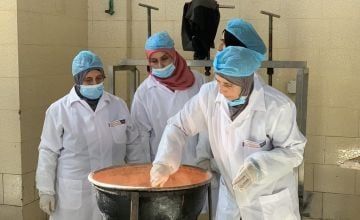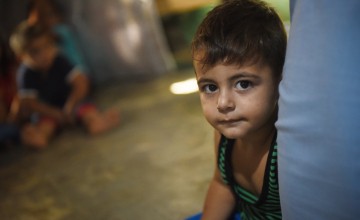
Knowledge Hub
We are currently living in the world’s largest refugee crisis on record, with more than 26 million people living away from home in host communities according to the United Nations High Commissioner for Refugees (UNHCR).
As the number of refugees has grown in recent years, however, so too has misinformation about where they’ve come from, where they go, and how they impact their host communities.
Here, we give you six facts about refugees you need to know.
Fact #1: Most refugees seek asylum close to home
Often, getting out of a country is a huge endeavour in terms of finances and human safety. For many refugees, the idea of entering a high-income country in Europe or the United States is a logistical impossibility. Most refugees seek asylum close to home, with 73% relocating to neighbouring countries. This isn’t always an ideal solution, as 86% of refugees are hosted in low-income and middle-income countries.
Additionally, some of the biggest host communities are ill-equipped to support their refugee populations. When you compare the countries that take in the most refugees to the world’s largest refugee crises, a few names make repeat appearances. It says a lot about the state of the world’s humanitarian crises when countries experiencing their own emergency situations (including conflict and climate extremes) are seen as viable alternatives to one’s own home country.
Lebanon has the highest number of refugees per capita, and concerns are high amid a growing economic and humanitarian crisis within the country.
The Democratic Republic of Congo is a good example of this: Following the Rwandan Genocide in 1994, the DRC became a host community to hundreds of thousands of refugees from the neighboring country.
This led to an outbreak of violence among Congolese, which has added to a decades-long humanitarian crisis that has made refugees out of over 800,000 DRC residents. However, the country is still host to nearly half a million refugees fleeing conflict in neighbouring countries, including Rwanda, the Central African Republic, South Sudan, and Burundi.

Fact #2: For most refugees, leaving is a last resort
A common characterisation of refugees is that they willingly leave their home countries in order to 'game the system'. But this couldn’t be further from the truth.
"I miss everything," Fatima*, a Syrian mother of four told us from her makeshift home in northern Lebanon. "Living in Syria was bounteous. I liked living near my parents and brothers and sisters."
For many, the decision to leave everything behind is a last resort.
Fatima’s village in Syria was surrounded by armed forces and subject to repeated bombings. She tried four times to get her children to safety before succeeding in escaping, thinking they would be gone for just a month.
When we spoke with Fatima, she was separated from her husband and parents, who were stuck in their village.
Meanwhile, as a single mother, she struggled to provide for her children in Lebanon’s informal displacement settlements. Millions will tell you that there is no system to game.

Fact #3: There’s a difference between refugees and migrants
We’ve gone over the differences between refugees, migrants, and internally-displaced people (IDPs), but it’s worth reiterating it here: While it may all seem one and the same to those of us who live and work in the same country where we were born, these distinctions carry big implications for millions.
Refugees face severe consequences for going back to the areas they leave. Often, they flee without essential paperwork, their belongings, or even family members. International law recognises this when protecting refugees. 'Migrant' is a slightly more flexible term, and for many migrant workers or immigrants, while their own survival may also be at stake, they don’t face the same life-or-death concerns as their refugee counterparts.
When we lump these two classifications together, we do a disservice to both groups of people.

Fact #4: Half of all refugees are children
An estimated 35 million forcibly-displaced people are children under the age of 18, according to the UNHCR.
The organisation also estimates that, of the 26 million refugees on earth today, 13 million are children. This includes 1 million children who were born as refugees - another UNHCR figure indicates that, for each year between 2018 and 2020, an average of 290,000-340,000 children were born to refugee parents. Many refugee children seek asylum without adult accompaniment or support.

Fact #5: Over 125,000 refugees were repatriated last year
Many of the refugees Concern works with still have the keys to their homes. However, as complex crises and protracted conflicts become the norm, this becomes less tenable over time. Syrian refugees, largely living in Turkey, Jordan, and Lebanon, have effectively put their lives on hold for over a decade without a sign of resolution. Afghan refugees have spent four decades living in host communities in Pakistan, with some families growing by generations while in displacement.
Many refugees leave thinking they will be gone for a few weeks or months. No matter how long it takes, many - like Syrian mother Khadija* - are ready to go back. "I aim to go back to Syria someday, rebuild my home, and use the same keys for it," Khadija told us from her temporary residence in Lebanon.
Despite ongoing conflict and crisis, more than 126,000 refugees returned to their country of origin during the first half of 2021, according to the UNHCR.
Ensuring that home communities are prepared for the influx of returnees is part of the repatriation process. Part of Concern’s work in Cambodia in the 1990s was helping with the transition to ensure that livelihoods and financial stability remained healthy as millions came home. What began as a small microfinance project at that time was divested to the members in 2003, and is now the largest provider of credit in Cambodia.

Fact #6: Anyone can become a refugee
Like we said above, a refugee is a legal classification that’s assigned after going through an asylum-seeking process. Different countries have different procedures, but there is still a process that must be followed.
There also has to be a specific criteria for seeking asylum as a refugee. For guidance, the 1951 Refugee Convention defines a refugee as anyone who "is unable or unwilling to return to their country of origin owing to a well-founded fear of being persecuted for reasons of race, religion, nationality, membership of a particular social group, or political opinion."
That said, our humanity is more fragile and tenuous than it may seem.
As we’ve seen in the last few years, an event beyond our control can upend our lives. Before civil war broke out in 2011, Syria had a thriving middle class and fleeing the country wasn’t something that many of its citizens thought about.
While many of us will never have to make the decisions that tens of millions have made, situations like these are a reminder that it’s not a distant impossibility. We owe it to those who have had to make this decision to offer our support and understanding wherever we can.
Do something amazing and take the Ration Challenge. Raise money and save lives
Other ways to help
Donate now
Give a one-off, or a monthly, donation today.
Join an event
From mountain trekking to marathon running, join us for one of our many exciting outdoor events!
Buy a gift
With an extensive range of alternative gifts, we have something to suit everybody.
Leave a gift in your will
Leave the world a better place with a life-changing legacy.
Become a corporate supporter
We partner with a range of organisations that share our passion and the results have been fantastic.
Create your own fundraising event
Raise money for Concern by organising your own charity fundraising event.





